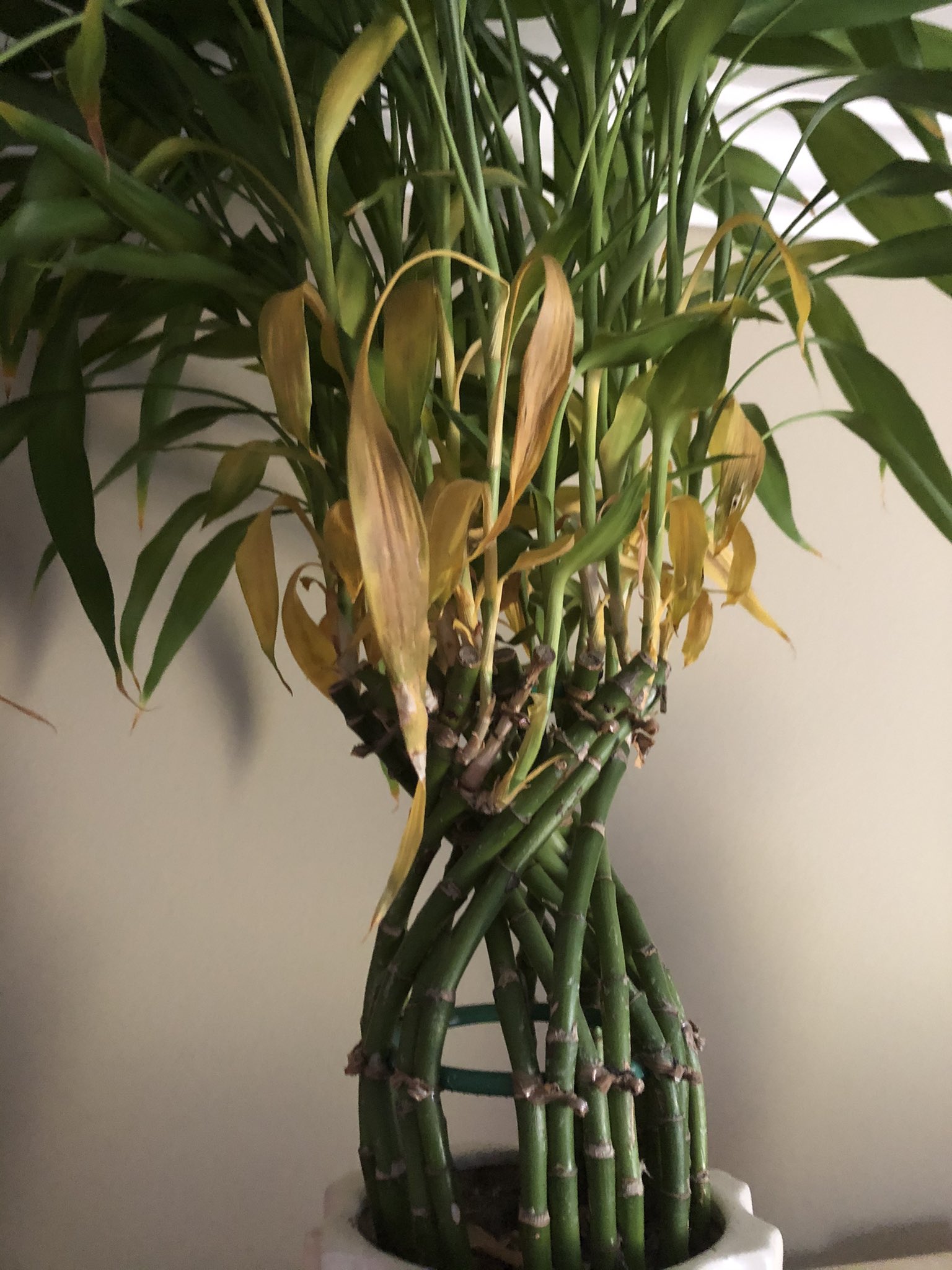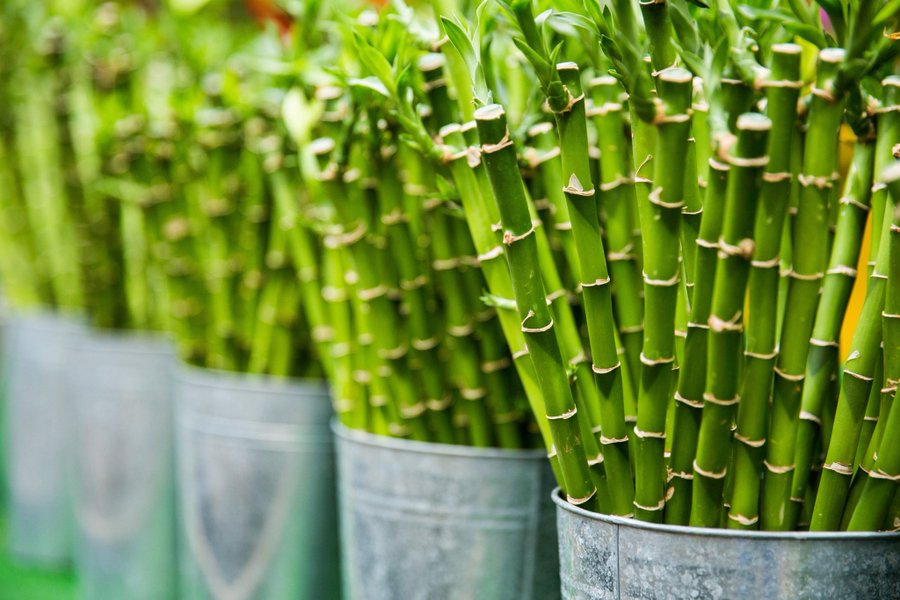Is your lucky bamboo turning yellow? You can potentially lose it if you do not take immediate actions to save it.
Lucky bamboo plants are not related in any way to the running or clumping bamboos, but rather one of the 40 cultivated species of the Dracaena group of plants. They are native to the Pacific Islands, especially Papua New Guinea, South East Asia and parts of Africa.
How to revive lucky bamboo turning yellow?
Lucky bamboo plants are tropical plants.
Generally, they are resilient to high temperatures, humidity and pests in the wild. But, several factors can affect their growth indoors.
We discuss the five common ones towards the end of this article.
First, here is how to revive a lucky bamboo plant in 3 steps if it turns yellow.
You will need:
- Candle wax
- Aloe vera
- Pair of secateurs
- Fresh/distilled water
- Plants rooting powder
 |
| Image credit: @Twitter |
Step 1 – Prepping lucky bamboo stalks
Separate the dying yellow lucky bamboo. Use the pair of secateurs to tidy up the stalks and yellow leaves.
Then, dip both the top & bottom ends of the cut lucky bamboo stalks in candle wax to prevent rotting. Then, place 3 to 5 stalks in the ‘growing medium’.
Step 2 – Making growth mixture
After that, create a growth-boosting mixture by mixing equal amounts of aloe vera gel and plant rooting powder.
Add the mixture into the ‘growing medium’.
Then, add water.
(Aloe vera gel and plant rooting powder are ideal for reviving dying plants. They are rich in nutrients the new plants need to grow)
Buy rooting powder at YouGarden
Step 3 – Reviving lucky bamboo turning yellow
The potted plants are in the medium are ready.
Finally, put them in a shaded area. The plants should show signs of new healthy plants after the first week.
Best way to revive a lucky bamboo turning yellow
Use either fresh rainwater or distilled water when replanting lucky bamboo, and when replenishing water in the pots.
Do not use tap water as it contains chlorine which tends to disturb the growth of new roots and shoots.
Prep the stalks neatly, and use rooting hormone and aloe vera to promote growth. Also, use a candle to stop the stems from rotting.
The chance of lucky bamboo plants surviving is slim if the stalks have turned golden yellow, and become squishy and wrinkling. This is the point of no return.
Separate the plant, and take action as soon as the leaves and stems turn yellow, and before the stalks turn from green to yellow.
How long before lucky bamboo plants recover?
As mentioned, the running bamboo will regenerate after 7, some quicker. But all in all, signs of new growth are eminent within the two weeks.
After that, you can re-pot the plant or leave them to grow in the ‘growing medium’.
In a case where you do not see any activity, the best thing to do is to give the plants time to grow. Check the water and any signs of rotting in the stems.
Read about the best practices for growing lucky bamboo plants in water, soil and gravel.
Why is lucky bamboo turning yellow?
There are several reasons why lucky bamboo leaves and stalks turn yellow. Below are the 5 common reasons why the yellowing of leaves happens.
Lucky bamboo leaves often turn yellow due to the lack of one (or more of) these plants’ growth needs.
They are important for the lucky bamboo to grow.
1. Freshwater
Use rainwater or distilled water. Lucky bamboo does not like warm water. Ensure that the water temperature remains consistent at room temperature, 20 - 25 degrees Celcius is ideal.
2. Sun
Place your lucky bamboo where it receives a good dose of filtered sunlight to regulate photosynthesis. They are tolerant to shade, but not to direct sunlight.
3. Improve humidity
Indoor air is often dry, it lacks good water content. In fact, lucky bamboo loves high humidity in the highs of 50%.
Let fresh air indoors. This will improve transpiration which is vital for the plant's natural colours.
4. Check the indoor room temperature
Indoor temperature is higher where there are electrical appliances. Like in 3 (humidity), the indoor temperature is vital for the houseplants.
The heat emitted by electrical appliances can affect the lucky bamboo plants. Check the indoor temperature if your plants show signs of distress.
5. Prevent rotting bamboo stalks
The lucky bamboo stalks will rot (where they are cut) when dipped in water. This is often the main cause of yellow leaves in lucky bamboo plants.
To avoid this problem, seal the freshly cut stalks with candle wax.
If a stalk turns yellow, it shows that it is not rooting. This is a dead plant and it should be removed and attended to immediately before it affects the other plants.
Use the 5 tips to keep your lucky bamboo happy and stop the leaves from turning yellow. Prevention is better that cure.
Grow lucky bamboo plants
In a case where your bamboo has turned yellow, revive it by using the three steps we discussed in ‘How to revive lucky bamboo turning yellow?’
In an ideal situation, prevention is better than cure. Be sure to replenish the water so that it remains clear all the time.
The bamboos are tropical plants. They will thrive in variable conditions. Attend to them immediately if you see any signs of distress in your plants.
Conclusion (Revive lucky bamboo turning yellow)
All in all, lucky bamboo plants are great indoor house plants.
As a gardener, you need to provide them with the right condition for them to thrive.
Knowing the 5 growth requirements is key to sustaining them.
Use the 3 steps to revive lucky bamboo if the leaves turn yellow. You may like to know about the 10 facts about lucky bamboo plants.
We hope this simple guide and best practices help you to revive your dying lucky bamboo plants.

